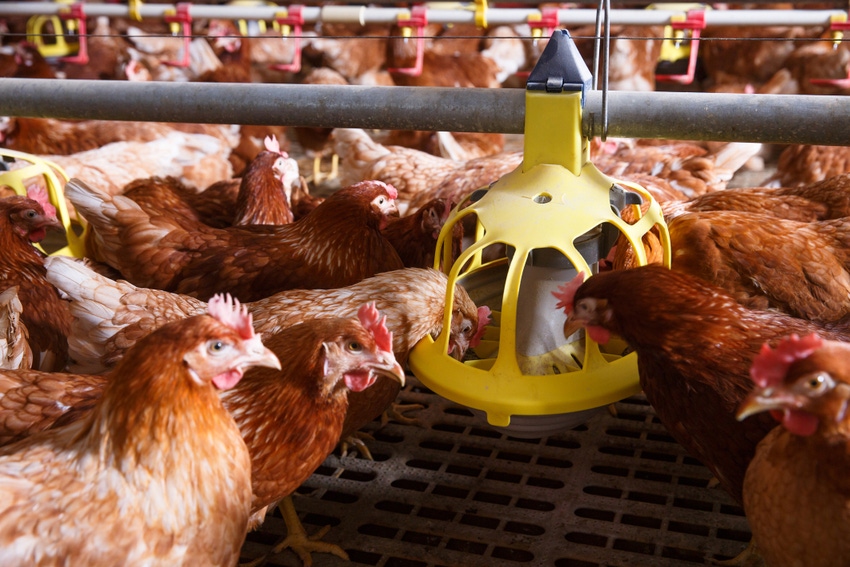DNA region contains important sensor for activating immune system.
February 8, 2018

One genetic region explains a large difference in possible disease resistance among chickens, according to researchers at Wageningen University & Research (WUR) and Hendrix Genetics in the Netherlands.
This DNA region contains, among other things, an important sensor for activating the immune system, which might explain why some chickens become ill and others do not, WUR said. This discovery will enable breeding organizations to select animals with a higher general disease resistance, which will result in reduced antibiotic use and improved animal welfare.
In poultry housing systems, animals frequently come in contact with each other. This enables a pathogen present in a barn to spread relatively easily among birds.
For decades, the poultry industry has searched for more robust animals -- those with good resistance against diseases. In addition, two recent management changes have been made: group housing of layer chickens and reducing (preventive) usage of antibiotics, both of which have increased the need for a more robust layer chicken, WUR said. One possible way to obtain this robust chicken is to breed for animals with a higher general disease resistance.
Antibodies are proteins present in sick animals that attack a pathogen. These antibodies are made only after the animal becomes infected with that pathogen. However, in addition to those antibodies, an animal also has natural antibodies (NAb).
NAb has only recently been discovered in livestock, WUR said. These antibodies are already present in healthy animals without (previous) exposure to a particular pathogen. NAb is important for fighting pathogens, as they inhibit and prevent further infection in the body but also warn and activate other parts of the immune system.
According to WUR, earlier studies show promising results: Higher NAb levels in layers were associated with an increased chance of survival, and since NAb levels are heritable, they can be influenced by breeding.
Identification of DNA region
To get a better understanding of which DNA region(s) contribute to the heritable variation, the WUR and Hendrix researchers investigated the whole genome of more than 1,600 chickens.
“We used genetic difference in the whole genome to identify DNA regions that occur more often in chickens with high NAb levels or in chickens with low NAb levels,” Tom Berghof, lead researcher of the study, said. One region had a very large effect on NAb level, which explained more than 60% of the genetic variation observed.
Within this region, one candidate gene could eventually be identified. Berghof added, “The region contained a few genes. It is very difficult to identify the difference at DNA level that explains the difference in NAb level. Most likely, this difference is due to the Toll-like receptor 1A (TLR1A) gene, which makes this our main candidate.”
TLR1A is member of the too-like receptor (TLR) family, an important part of the immune system. This is a group of receptors that recognize common structures on pathogens, WUR said.
“They detect certain parts present on many bacteria or viruses. These sensors have, therefore, a very broad function,” Berghof noted. In people, genetic mutations in TLR have been associated with an increased or reduced risk for diseases. Based on the study by Berghof and his colleagues, this seems to be the case in layer chickens, as well, although “the association with NAb is new, independent of the specie,” Berghof said.
Applications, future plans
This study offers direct applications for breeders to select layer chickens for increased disease resistance by selecting for this specific DNA region.
Frans van Sambeek, director research and development at Hendrix Genetics Layers, said, “Currently, we are investigating how we can apply these research findings into the breeding programs of purebred line. At this moment, we are running three field experiments with layers with high or low NAb levels. These hens will be monitored for livability and production.”
In addition, plans are being made to investigate the TLR1A-sensor.
“We have good indications that TLR1A is our candidate,” Berghof said. “However, this still needs to be proven.” A research proposal currently is being written to continue the investigation into the role of TLR1A in the immune system of chickens.
In the long term, this could result in, for example, improved vaccines and health-promoting nutrition. Eventually, this should lead to animals with a higher general disease resistance even with reduced antibiotic use, lower costs for farmers and improved animal welfare.
Read the full article in Frontiers in Immunology for more information.
You May Also Like


.png?width=300&auto=webp&quality=80&disable=upscale)
